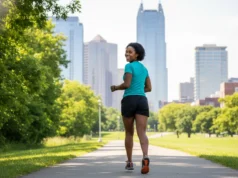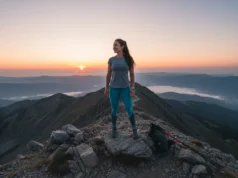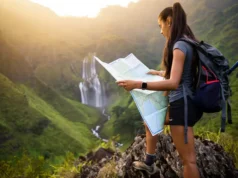In this article
The sidewalk ends where the urban inclines begin. That physical line marks the boundary between a casual commute and a legitimate physical discipline. As a mountaineering instructor who has spent decades training students for high-altitude objectives, I often find that the best training ground isn’t always a remote peak three hours away—it’s the vertical infrastructure of the city itself.
The modern urban hiking adventure is not a compromise for those trapped in the city. It is a specific athletic pursuit that hybridizes the accessibility of the metropolis with the physiological demands of backcountry trekking.
This urban adventurer’s field guide dismantles the binary distinction between “urban walking” and “wilderness hiking.” We are here to provide the operational intelligence required to turn local infrastructure—stairs, fire roads, and park-to-park trails—into serious urban fitness training grounds. From the verticality of San Francisco to the heat-hardened dirt trails of Phoenix, the concrete canyons offer a distinct theater for endurance and exploration.
The Paradigm Shift: Defining the Urban Hike
What distinguishes a legitimate urban hike from a leisure walk?
A legitimate urban hike is defined by three specific metrics: trail distance (typically exceeding 5 miles), elevation gain (500–2,000 ft utilizing topography or stairs), and surface type. It requires the athlete to transition seamlessly between abrasive paved paths and rugged single-track dirt trails within a single route.
Unlike a stroll through a park, the urban hike is an active “micro-adventure.” We look for routes that prioritize “Nature without the Drive,” where public transit access is a decisive ranking factor. This shifts the user intent from passive leisure to urban mountaineering conditioning, treating the city as a gym for vertical endurance.
This approach mirrors the “urban thru-hike” micro-model. We are seeing a rise in point-to-point routes, such as the 17-mile SF Crosstown Trail, which require urban logistics planning similar to backcountry trekking regarding ingress and egress points. The difference lies in the support system; instead of caching food in the woods, your urban trail planning integrates transit schedules and resupply points like coffee shops or bodegas.
The physiological impact is also distinct. Clinical studies regarding nature hiking interventions suggest that hiking in green and blue spaces yields higher symptom reduction scores than city walks alone. By connecting industrial infrastructure with pockets of urban wellness and natural resilience, we create a unique psychological “interconnection” distinct from pure wilderness immersion.
Pro-Tip: Treat your urban hike like a backcountry expedition regarding hydration. Just because there are convenience stores doesn’t mean you should skip carrying water. Aim to carry at least 1 liter to maintain pack weight for training purposes.
If you are ready to locate these hybrid routes, you can consult a definitive hiker’s field guide to urban hiking trails to start mapping your local vertical terrain.
Gear Systems for the Concrete Jungle
Why are hybrid shoes critical for mixed surfaces?
Hybrid shoes are critical because traditional stiff boots are too rigid for pavement, leading to impact fatigue, while standard road running shoes lack the protection and grip required for dirt sections.
We often see a biomechanical conflict in urban environments. The rapid transition from asphalt to loose gravel requires a “Hybrid Outsole.” You need a moderate lug depth of approximately 4mm. This grips loose dirt without creating uncomfortable pressure points on the hard asphalt sections.
Rubber compound chemistry plays a massive role here. We need a balance between soft, sticky rubber for wet rock traction and harder carbon rubber compounds necessary to withstand the rapid abrasion of concrete sidewalks. Additionally, the volume of cushioning is non-negotiable. High-volume EVA or nitrogen-infused midsoles found in cushioned asphalt runners are essential to dampen the repetitive shock of hard surfaces.
This “Door-to-Trail” versatility means your comfortable shoes transition visually and functionally from a pit stop to a steep dirt ascent without a gear change. Models like the HOKA Anacapa or Merrell Moab 3 bridge this gap effectively.
However, fit is critical. According to research on footwear dermatology and friction blisters, shear forces on hard surfaces can accelerate blister formation if the fit isn’t dialed in. Prioritize breathability over waterproofing, as heat retention from pavement can cook your feet in GORE-TEX liners.
For a deeper dive into selecting the right traction and fit, review our comprehensive guide on what shoes to wear when hiking.
Regional Field Guide: The West Coast Corridor
How do San Francisco and Los Angeles utilize verticality?
The West Coast defines the vertical urban hike. In San Francisco, the Crosstown Trail is the gold standard. This 17-mile diagonal traverse runs from Candlestick Point to Lands End. It is a true “urban thru-hike” anchored by metro access, specifically the Glen Park BART station.
For a shorter, atmospheric session, the Mount Sutro Loop offers a 2-mile route. It features soft dirt trails under a dense eucalyptus canopy that actively harvests fog, creating a rainforest feel minutes from MUNI bus lines.
Los Angeles offers a different challenge: exposed heat and raw elevation. Griffith Park routes, specifically the trek from Griffith Observatory to Hollywood Sign, are strenuous conditioning efforts. They offer significant exposure and elevation gain that rivals backcountry peaks, culminating in a classic view of the Hollywood Sign.
The critical asset here is the DASH Observatory Shuttle. It connects the Metro Red Line to the trailhead, exemplifying “Nature without the Drive.” Before heading out, always check Griffith Park trail maps and safety alerts for closure information.
Unlike the “Manhattan Schist” of New York, San Francisco’s radiolarian chert often necessitates stairs as trails. In LA, the safety concerns include extreme heat and urban wildlife—coyotes and rattlesnakes are common residents.
For a detailed analysis of hiking trails in Los Angeles, including specific trailhead access instructions and parking beta, refer to our regional breakdown.
Regional Field Guide: The Mountain West
How does ‘High Consequence’ terrain define Phoenix and Salt Lake City?
In the Mountain West, the city grid ends abruptly at the base of major peaks. Phoenix presents a lethal heat interface. The Holbert Trail to Dobbins Lookout in South Mountain Park is a prime example, passing ancient petroglyphs along the way. The “turn around when water is half gone” rule is not a suggestion here; it is a survival requirement.
Salt Lake City serves as the alpinist’s gym. The Mount Wire Loop offers a strenuous 2,000+ ft ascent used for mountaineering conditioning. It is accessible directly from the University of Utah/TRAX light rail.
Denver takes a different approach with the Denver Orbital Trail, a massive loop circling the metro area. Segment 13 utilizes the Cherry Creek Trail to connect the urban core to state parks via RTD Light Rail, allowing for massive distance days without a car shuttle.
This region presents a “Wilderness Interface” risk. You must be prepared for rattlesnakes, sudden thunderstorms, and steep, rocky terrain. The footing is often volcanic scree or steep limestone, requiring sturdier footwear than the dirt paths of the Pacific Northwest.
Pro-Tip: In Phoenix and SLC, shift your hiking window. “Alpine Starts” (beginning before dawn) are necessary to beat the heat and avoid UV exposure, which is significantly higher at altitude.
Always adhere to local heat safety guidelines for desert hiking before attempting these urban treks. For more options in the valley, check our decoded guide to hiking places in Phoenix.
Regional Field Guide: The East & Midwest Reclamation
How are industrial corridors being reclaimed for hiking?
The challenge in the East and Midwest is endurance and reclamation. NYC offers the “Giraffe Path,” a 6-mile vertical spine from Central Park to The Cloisters. It utilizes the A Train for egress and relies on massive public staircases to traverse the Manhattan Schist, proving that verticality exists even in the densest concrete jungles.
If you are looking for skyline views just across the river, our guide to the best hikes in North Jersey for skyline views provides accessible options that pair perfectly with an NYC itinerary.
Chicago focuses on biodiversity loops like the Chicago Outerbelt. LaBagh Woods Nature Observation Loop and the North Branch Trail offer a “secret escape” feel. Accessible via CTA bus, this riparian corridor provides solitude and birdwatching opportunities that defy the surrounding density.
Atlanta is building a Green Artery. The Proctor Creek Greenway connects the Bankhead MARTA station to Westside Park. It represents a “New South” approach to biological corridor recovery, linking neighborhoods through paved, accessible commuter paths.
Pittsburgh utilizes its industrial history with the Three Rivers Heritage Trail. Repurposed rail lines allow hikers to traverse the “Golden Triangle,” offering flat, high-mileage endurance walking through historic districts.
These trails validate the health benefits of greenways and urban trails, proving that reclaimed industrial land provides critical “urban refuges” for psychological relief and cooler microclimates.
Operational Fieldcraft & Safety Protocols
What specific safety protocols apply to the concrete jungle?
Safety in the city requires a different set of eyes than the woods. The most critical protocol is the “Headphones Rule.” We advocate for “Transparency Mode” or single-earbud use. You must maintain auditory situational awareness regarding traffic safety, cyclists, and pedestrians.
Treat traffic interfaces like river crossings. Assume drivers do not see you. Adhere strictly to pedestrian signals.
We also must adapt Leave No Trace principles. Wilderness ethics apply here but look different. Noise pollution is a major factor; keep Bluetooth speakers at home. Respect private property boundaries religiously.
For a deeper understanding of these principles, review the official Leave No Trace Seven Principles. We have also compiled a specific guide to mastering outdoor ethics that helps translate these rules to any environment.
Finally, conduct a “Street Smarts” assessment. Avoid unlit areas at night. Understand the social dynamics of the neighborhoods you are traversing. In the city, your “bailout” plan is often calling a rideshare or finding a bus stop, which changes your risk profile—but only if you have battery life. Carry a power bank.
Conclusion
The distinction between the city and the wild is often a matter of perception, not just geography. By adopting the mindset of the “Urban Alpinist,” you transform the city trails network into a legitimate training ground that builds endurance, tests gear, and sharpens navigation skills.
Whether you are traversing the fog-laden hills of San Francisco, the heat-shimmering ridges of Phoenix, or the reclaimed greenways of Atlanta, the urban hike offers a powerful tool for consistency. It brings the benefits of the backcountry into the rhythm of the work week. The trail is waiting, likely just a bus ride away; the only requirement is to treat the pavement with the same respect and preparation as the peak.
Key Takeaways:
- Define the Discipline: Urban hiking is defined by distance, elevation, and mixed surfaces.
- Gear Up: Use hybrid shoes with 4mm lugs and carry a security-focused daypack.
- Plan the Route: Prioritize trails with public transit access and map out urban resupply points.
- Stay Safe: Maintain situational awareness and adapt Leave No Trace principles.
Ready to map your own urban expedition? Explore our full library of regional hiking guides to find the hidden gems in your city, or share your favorite local urban hike in the comments below.
FAQ – Frequently Asked Questions
What is the difference between an urban hike and a city walk?
An urban hike involves significant physical exertion, typically distances over 5 miles and measurable elevation gain, whereas a city walk is leisurely. Urban hikes require urban logistics planning for transit and supplies, distinct from a casual stroll.
What shoes should I wear for urban hiking?
The ideal footwear is a hybrid shoe or trail runner with moderate cushioning and 4mm lugs, such as the HOKA Anacapa or Merrell Moab 3. Avoid heavy stiff boots and standard road running shoes.
Is it safe to hike alone in urban areas?
Yes, provided you use street smarts. Keep headphone volume low, stick to daylight hours in unfamiliar areas, and stay on designated popular hiking trails. Always have a charged phone and an exit plan.
How do I find urban hiking trails near me?
Look for greenways, rail-to-trail projects, or municipal parks with topography. Apps like AllTrails or Strava allow you to filter specifically for local hiking trails with elevation gain.
Risk Disclaimer: Hiking, trekking, backpacking, and all related outdoor activities involve inherent risks which may result in serious injury, illness, or death. The information provided on The Hiking Tribe is for educational and informational purposes only. While we strive for accuracy, information on trails, gear, techniques, and safety is not a substitute for your own best judgment and thorough preparation. Trail conditions, weather, and other environmental factors change rapidly and may differ from what is described on this site. Always check with official sources like park services for the most current alerts and conditions. Never undertake a hike beyond your abilities and always be prepared for the unexpected. By using this website, you agree that you are solely responsible for your own safety. Any reliance you place on our content is strictly at your own risk, and you assume all liability for your actions and decisions in the outdoors. The Hiking Tribe and its authors will not be held liable for any injury, damage, or loss sustained in connection with the use of the information herein.
Affiliate Disclosure: We are a participant in the Amazon Services LLC Associates Program, an affiliate advertising program designed to provide a means for us to earn advertising fees by advertising and linking to Amazon.com. As an Amazon Associate, we earn from qualifying purchases. We also participate in other affiliate programs and may receive a commission on products purchased through our links, at no extra cost to you. Additional terms are found in the terms of service.





